Sustainable exhibition stands: Are they the future of trade shows?
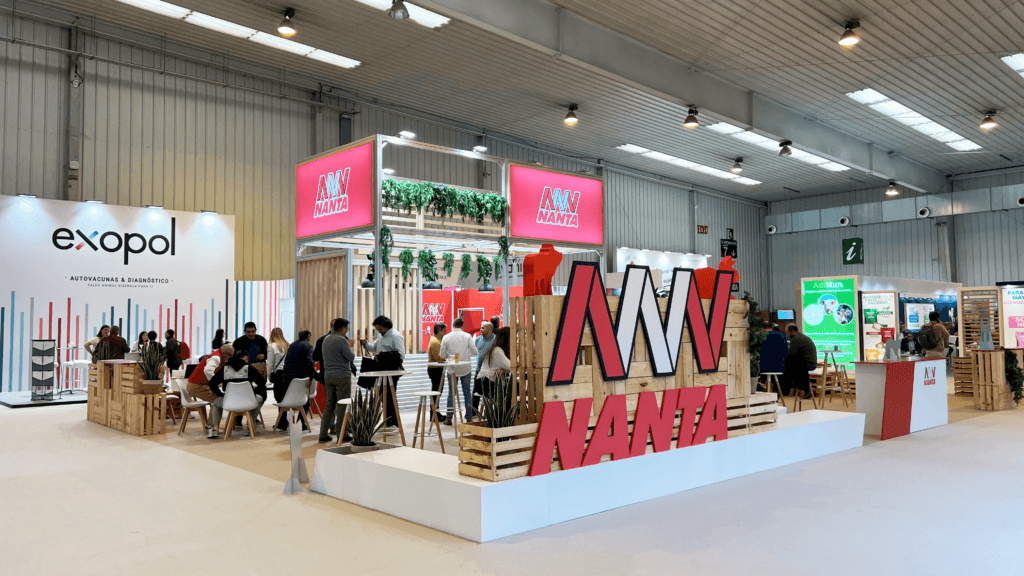
Sustainable exhibition stands | How to set one up for your trade show Sustainability is a key topic in today’s world, and companies taking part in trade shows and events are increasingly looking for environmentally responsible solutions. At Servis, we understand this need and offer sustainable exhibition stand designs that blend creativity, visual impact, and a strong commitment to the environment. Table of contents In this article, we’ll dive into what a custom-designed exhibition stand is and how it can help you stand out at trade shows and events. We’ll look at how it differs from modular stands and standard packages, as well as the benefits of choosing a custom or hybrid design. We’ll also break down the most commonly used materials—including modular options to help reduce costs and simplify setup—and walk you through the step-by-step process of creating a stand that’s visually appealing, functional, and aligned with your brand identity. What makes an exhibition stand sustainable? A sustainable exhibition stand is one that’s designed to minimize its environmental impact at every stage—from material selection to dismantling and potential reuse. Key features typically include: Use of recycled and recyclable materials: Such as FSC- or PEFC-certified wood, reusable aluminum, and displays made from recycled fabrics. Modular and reusable designs: Assembly systems that make it easy to take the stand apart and use it again at future events. Energy-efficient lighting: Incorporating low-consumption LED technology to cut down on energy use. Waste reduction: Sorting materials and reusing components like carpets and structural elements whenever possible. Local production and efficient transport: Lowering the carbon footprint by working with nearby suppliers. Benefits of sustainable exhibition stands 1. Strengthen brand image Today, sustainability is a key differentiator. An eco-friendly exhibition stand sends a clear message of environmental commitment and corporate responsibility. 2. Long-term cost reduction Using reusable structures and recyclable materials helps cut costs for future trade shows and events. 3. Standout appeal and visitor engagement Attendees appreciate companies that are committed to sustainability, which can lead to increased interest and foot traffic at your stand. How to create a sustainable exhibition stand 1. Planning and material selection From the very beginning, it’s important to choose materials that are recycled, recyclable, or reusable, while avoiding single-use options. Material selection should also take into account their origin—look for sustainability certifications like FSC or PEFC when using wood. It’s also wise to assess the durability of materials to extend their lifespan and reduce the need for frequent replacements. Additionally, planning should consider the environmental impact of the production process itself. Opting for low-carbon-footprint materials from local suppliers helps cut down on transportation and associated emissions. 2. Optimized setup and dismantling A modular exhibition stand can be reused across multiple events, helping to avoid unnecessary waste. These systems allow for flexible, customized designs without compromising sustainability, as they can be dismantled and reassembled with minimal material loss. To optimize this process, it’s best to design structures that require little to no adhesives or disposable elements during assembly. Choosing reusable fastening systems and lightweight, easy-to-transport materials also helps lower logistics costs and reduce waste. 3. Efficient energy use Choosing LED lighting and optimizing electricity use helps reduce energy consumption during the event. In addition to using energy-efficient LED bulbs, you can incorporate motion sensors and timers to prevent unnecessary energy use when the stand isn’t in operation. 4. Waste reduction and recycling Implementing waste management systems within the stand helps minimize waste generation and ensures proper disposal. It’s a good idea to provide separate bins to make it easy to sort recyclable, organic, and non-recyclable materials. Conclusion: The future of events has to be sustainable Future events need to align with sustainable practices to reduce their environmental impact without compromising effectiveness. Sustainability isn’t just a passing trend—it’s a necessary shift that’s changing how we interact with spaces and engage with attendees. Choosing responsible materials, energy efficiency, and waste reduction is key to making a meaningful difference. If you’re looking to bring sustainability into your events, starting with an eco-friendly exhibition stand is a great first step. At Servis, we can help you develop sustainable solutions without sacrificing design or innovation.
What kind of ceiling can I install in a trade show booth?
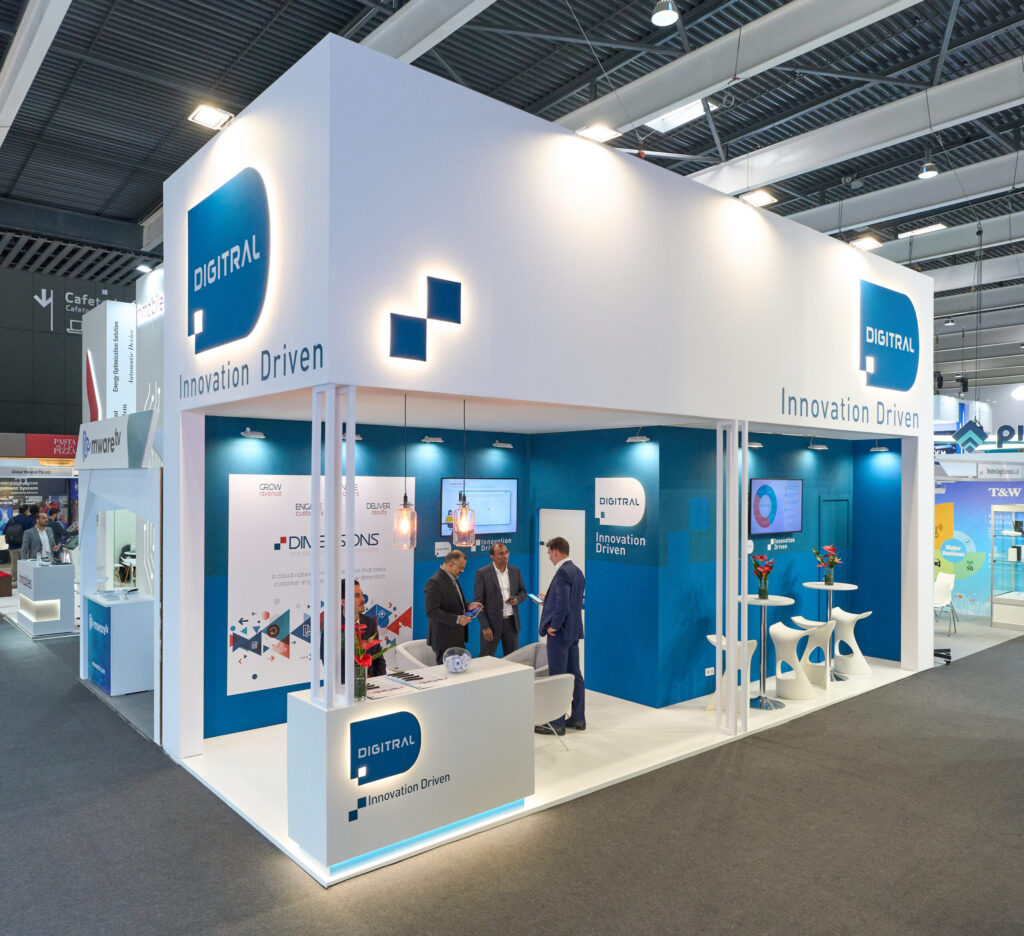
What kind of ceiling can you use for a trade show booth? At a trade show, the ceiling of a booth or pavilion is a crucial element, not just for the look of the space but also for its functionality. Choosing the right ceiling can make the difference between a booth that goes unnoticed and one that truly stands out. In this article, we’ll explore the most common ceiling options for trade show booths and highlight some key considerations to help you achieve a striking design. Table of contents In this article, we explain the importance of choosing the right ceiling for a trade show booth, covering options like tensioned fabric, canvas, mesh, rigid panels, and modular ceilings. We also share key tips on complying with venue regulations, optimizing lighting, and maintaining consistency with your brand image. At Servis, we help you create functional, eye-catching booths that stand out at any event. Ceiling options for trade show booths Tensioned fabric ceilings Tensioned fabric ceilings are becoming an increasingly popular choice thanks to their versatility and modern look. They use a flexible membrane stretched and secured to a perimeter frame, creating a clean, professional visual effect. Their main advantages include: Customization: They can be printed with graphics, logos, or brand colors to strengthen your visual identity. Lighting: They allow integrated lighting systems, creating eye-catching visual effects that draw visitors in. Lightweight and easy to install: These structures are simple to set up and transport, saving time and effort when managing event logistics. Canvas ceilings Canvas ceilings are an affordable and practical option for covering trade show booths: Flexibility: They can adapt to different booth sizes and shapes, offering practical coverage. Water resistance: They protect against leaks or condensation, which can be helpful in venues with humidity issues. Variety and customization: Canvas comes in a range of colors and can be customized with printed logos or promotional messages. Mesh or lattice ceilings Mesh or lattice ceilings are perfect for those looking to create an open, spacious feel in their booth: Natural ventilation: They allow air to circulate more freely, making the space more comfortable for visitors. Easy lighting integration: Ideal for hanging lighting systems that can adapt to the structure. Decorative versatility: These ceilings make it easy to hang decorative or promotional elements, giving you more options to design an eye-catching booth. Panel ceilings Rigid panel ceilings provide a professional look and are especially useful when you need better insulation or a solid structure: Sound and thermal insulation: They offer improved control over noise and temperature inside the booth. Sturdy construction: Ideal for booths that require greater durability and strength. Range of finishes: Available in materials like wood, metal, or plastic, allowing you to choose the finish that best matches your brand identity. Modular ceilings Modular ceilings are practical for booths that need to be set up and taken down frequently: Easy assembly: They can be put together and dismantled quickly, saving time and effort. Adaptability: They can be reconfigured for different booth sizes, offering greater design flexibility. Compact storage: When disassembled, they take up little space, making transport and storage much easier. Key factors for choosing a trade show booth ceiling When choosing the right ceiling for your booth, there are several important factors to keep in mind: Venue regulations: Make sure you comply with the height and safety rules set by the trade show venue. Lighting: The ceiling should allow for proper lighting to highlight your products or services and draw visitors in. Brand image: The ceiling design should match your company’s visual identity, projecting professionalism and style. Functionality: Consider whether you need to hang decorative or audiovisual elements from the ceiling, or if you want to include specific lighting systems. Budget: Strike a balance between the cost of the ceiling and the visual and functional impact you want to achieve. Conclusion Choosing the right ceiling for your trade show booth can have a big impact on the success of your presence at the event. A well-designed ceiling not only enhances the booth’s appearance but also improves the visitor experience, making people feel welcome and engaged in your space. At Servis, we’re committed to helping you design functional, eye-catching booths tailored to your brand’s needs. Count on us to make your booth shine at your next trade show!
Livestock Trade Shows: what they are and their benefit
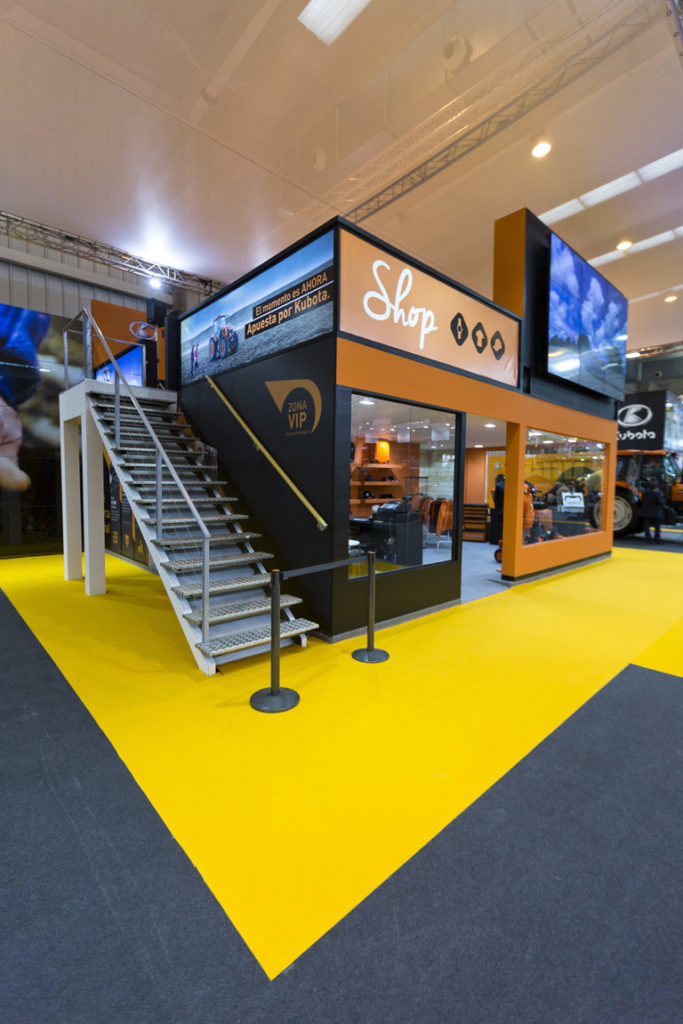
Livestock Trade Shows: what they are and their benefit Livestock trade shows are much more than just commercial showcases. They’re strategic opportunities for networking, boosting brand visibility, and sharing knowledge within the agricultural industry. These events bring together tradition and innovation, reinforcing their role as key platforms for industry growth. If you’re thinking about participating in a livestock trade show—whether you’re a first-time exhibitor or looking to enhance your presence—this article offers practical tips to help you get the most out of your investment and strengthen your position in the market. Table of contents If you’re planning to take part in a livestock trade show, whether you’re exhibiting for the first time or looking to maximize your presence, this article shares practical tips to help you get the most out of your investment and boost your visibility in the market. What is a livestock trade show, and why does it remain a key part of agricultural marketing? A livestock trade show is a specialized business event that brings together producers, distributors, veterinarians, investors, and the general public interested in the livestock industry. These agricultural trade shows have evolved to meet the needs of an increasingly global and tech-driven sector. They’re no longer just about showcasing animals—they now highlight innovations in genetics, nutrition, equipment, and related services. It’s where business deals are made, knowledge is shared, and market trends are closely observed. Despite the rise of digital tools, in-person livestock events remain essential for building trust and personal connections in an industry as traditional as agriculture. They offer hands-on access to products, live demonstrations, and face-to-face conversations that are hard to replicate in virtual settings. What are the most important livestock trade shows? Spain and Latin America host a wide range of internationally recognized livestock trade shows. Some of the most prominent events include: FIGAN (Zaragoza, Spain): Widely regarded as a benchmark for agricultural innovation, FIGAN welcomed over 1,200 exhibitors and 60,000 visitors in its most recent edition. It’s a top venue to discover the latest advances in livestock machinery, genetics, and technology. FIMA (Zaragoza, Spain): While primarily focused on agricultural machinery, FIMA also features areas dedicated to livestock solutions, including facilities, equipment, animal nutrition, and health. Expoagro (Argentina): With nearly two decades of history, Expoagro is one of the most important agribusiness events in Latin America. Alongside its large machinery displays, it offers a strong livestock section featuring cattle, sheep, and goat breeds, along with dedicated spaces for technical and commercial networking. Agroexpo (Colombia): This show brings together key players in Colombia’s agricultural sector and the Andean region. The program includes livestock judging, auctions, dairy product quality contests, and spaces focused on rural innovation. Expointer (Brazil): Held at the Assis Brasil exhibition park, which spans over 400,000 square meters, Expointer is one of the largest agricultural fairs in the world. It serves as a strategic meeting point for companies looking to enter the Brazilian market. What are the benefits of exhibiting at a livestock trade show? Exhibiting at a livestock trade show can be a game-changer for any business in the agricultural sector. Here are some of the key benefits: Brand visibility among a highly targeted audience: These events attract professionals with a genuine interest in livestock products and services. It’s a prime opportunity to increase brand exposure and stand out from competitors in front of potential clients. Lead generation and strategic partnerships: Direct interaction with industry visitors makes it easier to identify business opportunities and build strong relationships. Many trade shows also offer structured B2B meeting agendas to facilitate high-value networking between exhibitors and buyers. Product launches in a specialized environment: If you’re introducing a new product, service, or innovation, a trade show is the perfect setting to showcase it, gather real-time feedback, and spark interest from a qualified audience. Stronger positioning in a rapidly evolving sector: Livestock farming is undergoing major shifts driven by technology, sustainability, and changing market demands. Demonstrating how your solutions align with these trends can strengthen your position and credibility in the industry. What logistics should you plan before attending a livestock trade show? Solid operational planning is key to making your trade show participation a success. Here are some essential logistics to take care of before the event: Booth reservation and setup schedule: Book your space well in advance and make sure you’re clear on the deadlines for setup and teardown. Some trade shows offer turnkey services that can simplify the process. Technical and health requirements: Inform the organizers about your needs for electricity, water, internet, and other essentials. If you’re displaying animals or fresh products, check the legal and sanitary regulations you’ll need to comply with. Transport and storage: Plan how your materials and products will be transported. There are logistics companies that specialize in trade show support, including temporary storage and on-site assistance. Team coordination: Assign clear roles, shifts, talking points, and customer service guidelines for your booth staff. Make sure you have enough brochures, product samples, and promotional materials ready. Creating a detailed checklist of all pre-show tasks—with assigned responsibilities and progress tracking—can be extremely helpful. It’s also wise to appoint someone as the main point of contact for coordinating with the event organizers and external vendors. How much does It cost to exhibit, and how do you measure the return on investment? The cost of exhibiting can vary depending on several factors: Booth size Type of booth (modular vs. custom-built) Additional technical services Travel and accommodation for your team Production of promotional materials In addition to these visible expenses, there are also less obvious ones—like the time your team invests or the follow-up work afterward—that should be factored into your overall budget. On this page, you’ll find a tool that helps you estimate the cost of setting up a booth using our VisualWall system. To measure return on investment (ROI), it’s important to define clear goals before the event—such as the number of leads, meetings, open opportunities, and projected sales. While there are specialized tools for calculating trade
How much is a booth?
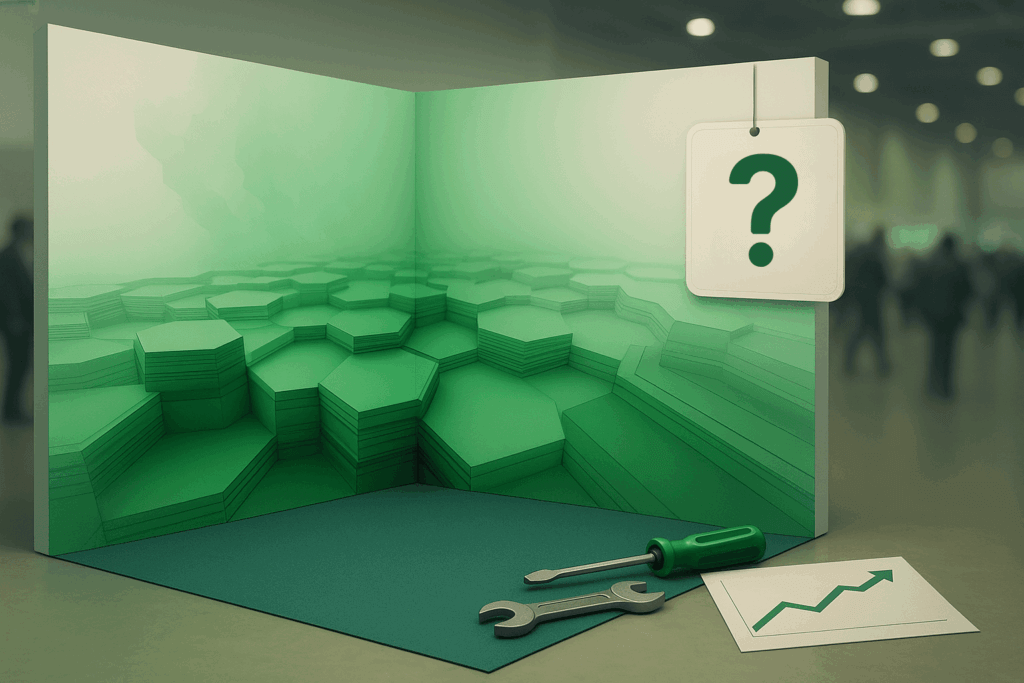
How much does a booth at a trade show cost? There’s no single answer, but there is a clear way to figure it out Table of contents Want to know how much YOUR booth will cost? We know every company and every trade show is different. That’s why we created a tool that lets you estimate the approximate cost of your fully assembled booth—using our new VisualWall system—in under a minute When a company decides to take part in a trade show, there’s always one question that comes up before making the leap: how much does a booth cost? While there’s no one-size-fits-all answer, there are several key factors that directly impact the final budget. In this post, we’ll help you understand all the variables that affect booth pricing—and we’ll share a tool that lets you calculate your budget online in under a minute. Taking part in a trade show: investment or expense? A booth isn’t just a physical space inside an exhibition hall. It’s your business card, your temporary storefront, your showcase. And its cost depends on much more than just the square footage. Making smart choices and planning strategically can be the difference between going unnoticed and making valuable connections—and sales. Booth types: modular, custom-built, or hybrid? The first step in estimating the cost of a booth is knowing exactly what type you need. Here’s a breakdown of the main options: Modular booth It’s the most affordable and quickest option. It uses pre-configured structures that can be customized with your own graphics. Perfect if you’re just starting out or attending multiple trade shows on a tight budget. Prices typically start at €150 per square meter. Custom-built booth Fully custom-designed. Ideal if you’re aiming for strong visual impact, want to stand out from the competition, and showcase your brand identity. Prices typically range from €300 to €600 per square meter, depending on the level of customization and materials used. Hybrid booth A combination of modular structure and custom-built elements. It delivers an attractive look at a more balanced cost. Highly recommended for companies looking to level up their presence without going over budget. More information about booth types Factors that influence the cost of a booth Beyond the type of structure, there are other key elements that play a major role in determining how much a booth at a professional trade show will cost. Surface area (m²) It’s the foundation of your budget. You’re not just paying more for taking up more space—you’ll also need more structure, more design work, and more staff. Most costs are calculated per square meter, and this is where a large portion of your investment goes. Materials and finishes The difference between a booth with PVC walls and one built with wood, acrylic, or premium finishes can add up to hundreds—or even thousands—of euros. Materials directly affect the perceived quality of your space… and your overall budget. Audiovisual elements LED screens, decorative lighting, ambient sound, touchscreens… These features can significantly boost your booth’s appeal—but they also drive up the cost. In some cases, audiovisuals can account for up to 30% of the total budget. Transport, setup, and teardown Especially if you’re exhibiting at trade shows outside your city. This category includes packing, logistics, technical staff, and setup time. Partnering with a company like Servis, which handles everything for you, helps avoid surprises and keep costs under control. Additional services Don’t forget to include: Furniture (tables, chairs, counters) Printed or backlit graphics Daily cleaning services Staff for customer service Catering, Wi-Fi, or storage Travel expenses Meals and per diem Hotel accommodations It all adds up—and if you don’t factor it in from the beginning, it can throw your entire budget off track. Conclusion: Your booth, your most valuable investment Knowing how much a booth costs is essential when planning your trade show presence. It’s not just about choosing the cheapest option—it’s about finding the right balance between budget, visibility, and results. At Servis, with over 60 years of experience, we offer something every company needs when exhibiting: the peace of mind that comes from knowing everything will go smoothly.
A complete guide to organizing professional events

Complete guide to professional event organization Event organization has become a key strategic tool for companies looking to stand out in an increasingly competitive market. Table of contents The events sector in Spain has undergone a major transformation in recent years, showing remarkable resilience in adapting to market changes and shifting audience expectations. After the impact of the pandemic, the industry has made a strong comeback with new formats that blend the best of both in-person and digital experiences. Investing in well-organized corporate events delivers tangible benefits for companies, including increased generation of qualified leads, stronger brand image, and improved customer loyalty. Types of professional events and their key features Trade shows and exhibitions Trade shows offer a unique opportunity for companies to showcase their products and services directly to a target audience that’s already interested in the industry. These events bring together competitors, suppliers, and potential clients all under one roof. Participating in a trade show requires detailed planning—from strategic booth design and staff training to preparing effective promotional materials. The main goal is usually to generate qualified leads that can later turn into loyal customers. The most successful trade show appearances are those where companies create a memorable presence that truly reflects their brand identity and corporate values. Conferences and congresses Congresses and conferences are primarily focused on knowledge sharing and the exchange of ideas among professionals within the same industry. These events emphasize valuable content and require a carefully curated lineup of speakers. Organizing a successful congress involves close attention to key elements such as: Proper acoustics and high-quality audiovisual systems A well-structured agenda with a balanced pace Thoughtfully designed networking areas Efficient registration and attendee management Hybrid events Hybrid events have emerged as an innovative solution that blends the traditional in-person experience with virtual components accessible to remote audiences. This format allows for greater geographic and demographic reach without sacrificing personal interaction. To successfully implement a hybrid event, you’ll need: A robust tech infrastructure that supports both in-person and virtual attendees Inclusive engagement to avoid a “first-class vs. second-class” attendee experience Content tailored to different ways people consume information Cross-networking opportunities that connect virtual and in-person participants Key phases in planning a professional event Defining objectives, KPIs, and budget Effective planning starts with a clear definition of what the event is meant to achieve. Objectives should be specific, measurable, achievable, relevant, and time-bound. The budget must account for every aspect of the event—from obvious items like venue rental to often-overlooked details such as insurance, permits, and unexpected costs. It’s advisable to include a 10–15% buffer for contingencies. The KPIs you choose should align directly with your objectives and may include metrics such as: Number of attendees and conversion rate Quantity and quality of leads generated Digital engagement during and after the event Choosing the right format, date, and location The event format should be directly aligned with your defined objectives and tailored to your target audience. Choosing the right date involves analyzing the industry calendar to avoid overlaps with other major events. The ideal location should strike a balance between several key factors: Accessibility and transportation options to make attendance easy Capacity and flexibility of the space to suit your specific needs Available support services such as catering and nearby accommodations Consistency with your brand image and the values you want to communicate Creating the timeline and assigning responsibilities A detailed timeline is the backbone of any successful event. It should cover all stages of the project—from the initial concept to post-event evaluation—with clearly defined milestones and realistic deadlines. Responsibility should be assigned based on each team member’s specific skills, with a clear definition of who is accountable for each area. Establishing effective communication channels is also key to ensuring smooth coordination and successful execution. Strategic space design and event experience Creative conceptualization aligned with brand identity The event’s creative concept should be rooted in a deep understanding of the brand’s identity and the values the company wants to communicate. This concept serves as a unifying thread that brings coherence to every element of the event. A well-developed concept allows for the creation of an immersive narrative that emotionally connects with attendees and reinforces key messages. This storytelling approach helps make the experience memorable and ensures participants associate positive values with the organizing brand. Experiential elements that enhance interaction ncorporating elements that engage the senses and encourage active participation is a powerful differentiator. Immersive experiences create lasting memories and strengthen emotional ties with the brand. Some effective experiential elements include: Live product demos that allow hands-on interaction Sensory activations that engage multiple senses for deeper impact Interactive technologies that invite exploration and discovery “Instagrammable” moments designed to spark social sharing and expand your event’s reach Technology integration Well-implemented technology acts as an invisible enabler—it enhances the attendee experience without stealing the spotlight. Tech solutions should respond to specific needs and deliver tangible value. Practical technologies for events include: Check-in systems with facial recognition or QR codes Mobile apps offering personalized information and real-time updates Networking platforms that make it easy to connect with other attendees Augmented reality to enrich content and create interactive layers of information When thoughtfully integrated, technology supports smoother operations, deeper engagement, and a more impactful overall experience. Essential logistical elements Vendor management and contracting Selecting and coordinating vendors requires a systematic approach to ensure the quality of contracted services. Contracts should be detailed, covering delivery timelines, technical specifications, and clear responsibilities. Recommendations for effective vendor management: Build a vetted supplier database based on performance and reliability Request verifiable references from similar past projects Document all agreements and changes in writing to avoid misunderstandings and ensure accountability A structured, transparent process not only minimizes risks but also builds strong, long-term relationships with trusted partners. Licenses, permits, and legal considerations Regulations for events in Spain can vary depending on the autonomous community and the municipality where the event takes place. Administrative procedures often involve lead times that should be built into the overall
Creative booths

Creative booths: turning your trade show presence into a powerful brand experience In the competitive world of trade shows and business events, the way you present your brand can make or break your participation. Creative booths have become essential for capturing visitors’ attention in environments where dozens, or even hundreds, of companies are vying to stand out. Table of contents In this article, we’ll explore the keys to creating truly creative booths, take a look at current industry trends, and break down the design process. We’ll also cover ways to measure return on investment and highlight success stories that can inspire your next trade show or corporate event appearance. What defines a truly creative booth? A truly creative booth goes far beyond eye-catching aesthetics or the use of vibrant colors. It’s a comprehensive solution that blends design, technology, functionality, and brand storytelling to deliver a unique and cohesive experience. What sets a creative booth apart from a conventional one is its ability to communicate the company’s values and identity in an innovative way, creating an emotional impact on visitors. Striking the right balance between beauty and utility is also key. A booth may look stunning, but if it fails to meet basic requirements—such as encouraging visitor interaction, offering suitable spaces for meetings or presentations, or clearly communicating the brand’s key messages—it will fall short of its core purpose. Creativity should always serve the company’s business and communication goals. The visitor experience is the third essential pillar. A creative booth carefully considers the physical and emotional journey of each guest, always aiming to create meaningful, lasting impressions. Thoughtful interaction with booth elements, multi-sensory engagement aligned with the brand, and the creation of memorable moments are what truly distinguish a creative booth from one that simply looks good in photos. The latest trends in creative booth design Sustainability and eco-friendly materials Sustainability is no longer optional—it’s become a requirement in booth design. Companies are increasingly incorporating sustainable materials that not only reduce environmental impact but also communicate a genuine commitment to sustainability. Options like certified wood, biodegradable plastics, and high-strength cardboard allow for visually striking designs without compromising environmental responsibility. Modular booth systems designed for reuse are also gaining ground. These setups can be reconfigured to fit different spaces and layouts, extending their lifespan and improving the return on the initial investment. They also make transport and storage easier, helping to reduce the carbon footprint associated with moving bulky materials between trade show locations. The positive impact of these initiatives on brand perception shouldn’t be underestimated. As visitors grow more aware of environmental issues, they tend to respond favorably to companies that embrace sustainable booths. This alignment between stated values and real-world actions strengthens brand authenticity and can serve as a powerful differentiator—especially in industries where sustainability is increasingly seen as a core value. Immersive and experiential technology The integration of augmented and virtual reality is transforming the way visitors engage with booths. These immersive technologies break the physical limitations of space, enabling experiences that would otherwise be impossible to recreate. From visualizing full-scale products that wouldn’t physically fit in the booth to taking virtual tours of company facilities located thousands of miles away, the possibilities are virtually limitless. Interactive screens and touch technology have evolved into essential features of any modern booth. Beyond simply playing corporate videos, these tools allow for dynamically personalized content based on each visitor’s profile and interests. Product configurators, brand-related interactive games, and gamified digital surveys are just a few examples of applications that enrich the visitor experience. Functional minimalism In contrast to the long-standing trend of overcrowding booths with information and stimuli, functional minimalism embraces clean designs that amplify the brand’s core message. This “less is more” philosophy doesn’t mean sacrificing creativity—it means focusing it on solutions that strip away the unnecessary to highlight what truly matters. A clean, thoughtfully designed space conveys professionalism and trust, while also providing the visual breathing room many visitors appreciate in the often-overwhelming trade show environment. Making the most of available space has become a top priority, especially considering the high cost per square meter at major international trade shows. Minimalist designs often include clever, multifunctional solutions such as transformable furniture, integrated storage, or modular structures that can be reconfigured as needed throughout the event. This flexibility helps maximize ROI and adapt the booth to different uses over the course of the day. Versatility and adaptability to different events is another key advantage of this approach. A well-designed minimalist booth can be easily adjusted to fit various booth sizes and layouts while consistently maintaining brand identity and visual coherence. This is particularly valuable for companies that exhibit at multiple events throughout the year, allowing them to maintain a recognizable and professional presence no matter the venue. The creative booth design process Concept development phase Every successful booth starts with a clear definition of the business and communication goals it aims to achieve. This initial phase requires close collaboration between the marketing team and the designers to define what success looks like: is the goal to generate qualified leads? Strengthen brand image? Launch new products? Each objective calls for different strategic decisions regarding space layout, element placement, and key messaging. Analyzing the target audience and their specific behavior at trade shows is essential for effective design. Designing a booth for industrial engineers is very different from designing one for graphic design professionals—each group has distinct sensory expectations and information priorities. Understanding how these professionals navigate trade shows in their industry, what types of interactions they value, and how much time they typically spend at each booth provides crucial insights for optimizing the visitor experience. Technical planning Spatial considerations and venue restrictions play a key role in guiding many decisions during this phase. Each trade show venue has its own regulations regarding maximum height limits, anchoring points, available electrical load, and material restrictions—all of which can significantly impact the design. A thorough analysis of these parameters, along with ongoing communication with
What is a customized exhibition stand design?
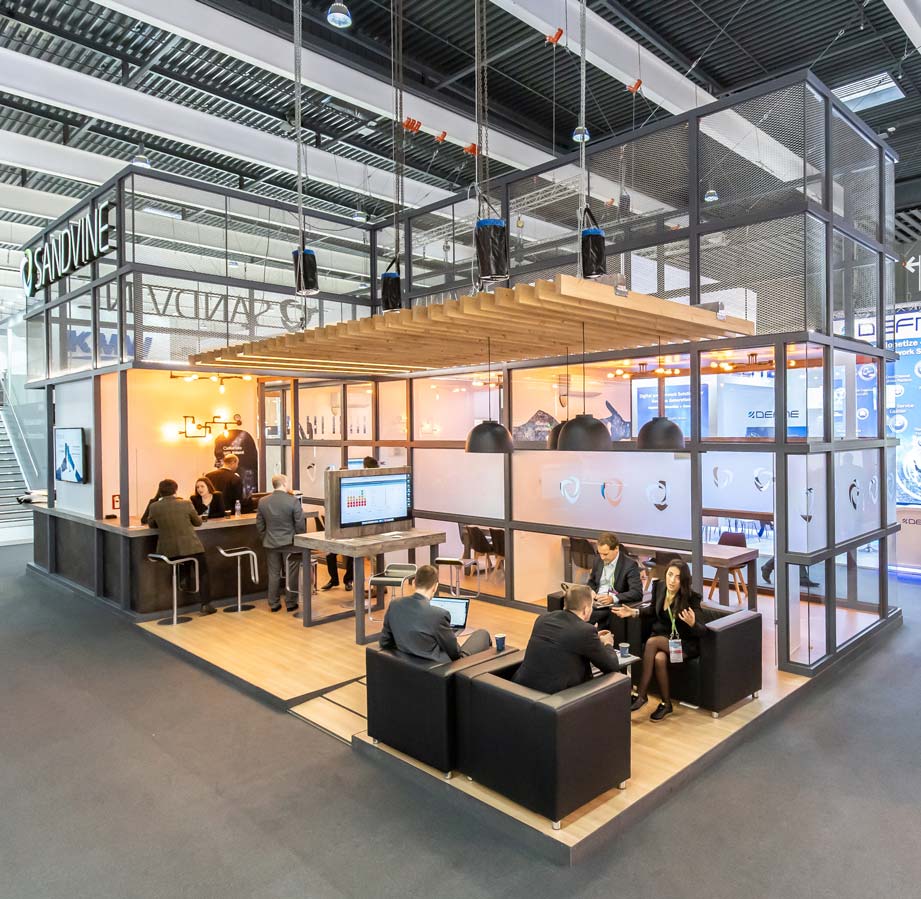
What does a customized exhibition stand design mean? In the world of trade shows and exhibitions, customized exhibition stand design plays a key role in capturing the audience’s attention and reflecting a brand’s identity. Among the available options, a customized stand stands out as the most tailored and distinctive alternative. But what makes it special, and how does it differ from other choices like modular stands or exhibition packages? In this article, we’ll cover everything you need to know to choose the best solution for your company. Table of contents In this article, we will discuss what a customized exhibition stand design is and how it can help you stand out at trade shows and events. We will explore its differences from modular stands and standard packs, as well as the benefits of choosing a customized or hybrid design. Additionally, we will analyze the most commonly used materials, including modular options to optimize costs and assembly, and go through the step-by-step process of creating a stand that is attractive, functional, and aligned with your brand identity. What is a customized exhibition stand design? A customized exhibition stand design is a tailor-made display space, free from the limitations of predefined structures. This means every element of the stand is designed and built according to the exhibitor’s needs, from layout to materials, colors, and decorative elements. Unlike modular stands, which follow standard patterns, this type of design maximizes creativity and brand identity, resulting in striking, innovative, and fully functional spaces. However, this doesn’t mean a customized stand can’t include modular elements. In many cases, hybrid designs are created, combining custom structures with modular systems to optimize costs, improve installation efficiency, or reuse certain components for different events. How does a customized exhibition stand design differ from a modular stand? The main difference between a customized exhibition stand design and a modular stand lies in the level of personalization and design flexibility. Modular stand (pre-fabricated): Made of standard, pre-built structures, usually aluminum and panels, which limit creativity and customization. They are quicker to install, cost-effective, and sustainable but offer less visual impact. Fully customized exhibition stand design: Allows for tailor-made architectural shapes and the use of custom materials like wood, aluminum, glass, LED screens, suspended structures, and interactive elements. The goal is to stand out at the trade show and effectively convey the brand’s identity. Hybrid stand: Combines custom design elements with modular structures. This option helps reduce costs while maintaining differentiation and flexibility, making installation easier and allowing reuse for multiple events. If your company wants to stand out and has the necessary budget, a fully customized exhibition stand design is the best choice. If the budget is more limited, a hybrid stand can also be a great option. What is a stand pack, and why is it the opposite of a customized exhibition stand design? At many trade shows, organizers offer a stand pack option. This alternative includes a basic pre-assembled space with a standard modular structure, carpeted flooring, simple furniture (such as a table and chairs), a name sign for the company, and electrical connections. A stand pack is a cost-effective and quick solution for companies with limited budgets or those looking for a simple presence at the event. However, if your goal is to make an impact, attract visitors, and strengthen your brand image, this is not the best choice. Features: Stand Pack Customized exhibition stand design Customized Very low Fully customizable Materials Prefabricated panels and aluminum Wood, aluminum, LED, glass, etc. Visual Impact Basic High impact and differentiation Cost Cheaper Higher investment Assembly time Faster Customized planning and assembly Benefits of a custom-designed exhibition stand Differentiation and exclusivity: With a 100% customized design, your stand will be unique at the trade show and will stand out from competitors. Greater visual impact: Incorporating technology, lighting, and innovative materials helps capture attendees’ attention. Brand identity reinforcement: You can design it according to your company’s values and aesthetics, delivering a consistent brand message. Optimized space utilization: It’s tailored to your specific needs, allowing dedicated areas for demonstrations, meetings, or visitor interactions. Immersive experience: An engaging and interactive design enhances visitor experience and encourages greater participation. Most common materials used in custom-designed stands Custom or bespoke designs allow the use of a wide variety of materials depending on the brand’s concept and needs: Custom carpentry: Enables the creation of tailored structures and exclusive decorative elements. Aluminum and metal: Provides a modern aesthetic and facilitates lightweight yet sturdy constructions. Glass and acrylic: Adds sophistication and allows for visually appealing effects. LED lighting: Enhances the stand’s visibility and creates distinctive atmospheres. Interactive screens and audiovisual elements: Generate dynamism and attract visitors’ attention. Modular structures: Can be integrated when the stand’s design permits, optimizing costs and simplifying assembly without compromising customization. Conclusion A custom-designed booth is the ideal choice for companies looking to stand out at trade shows and events, as it allows you to create a unique space that aligns with your brand identity. Unlike modular and pre-packaged stands, which follow predefined structures, a custom-designed booth offers total freedom to integrate innovative elements and deliver a memorable experience for attendees. If your goal is to boost your presence at a trade show, attract more customers, and strengthen your corporate image, choosing a custom-designed booth is the best strategy. Make your brand shine and leave a lasting impression at your next event!
What are modular booths and when are they the right choice?
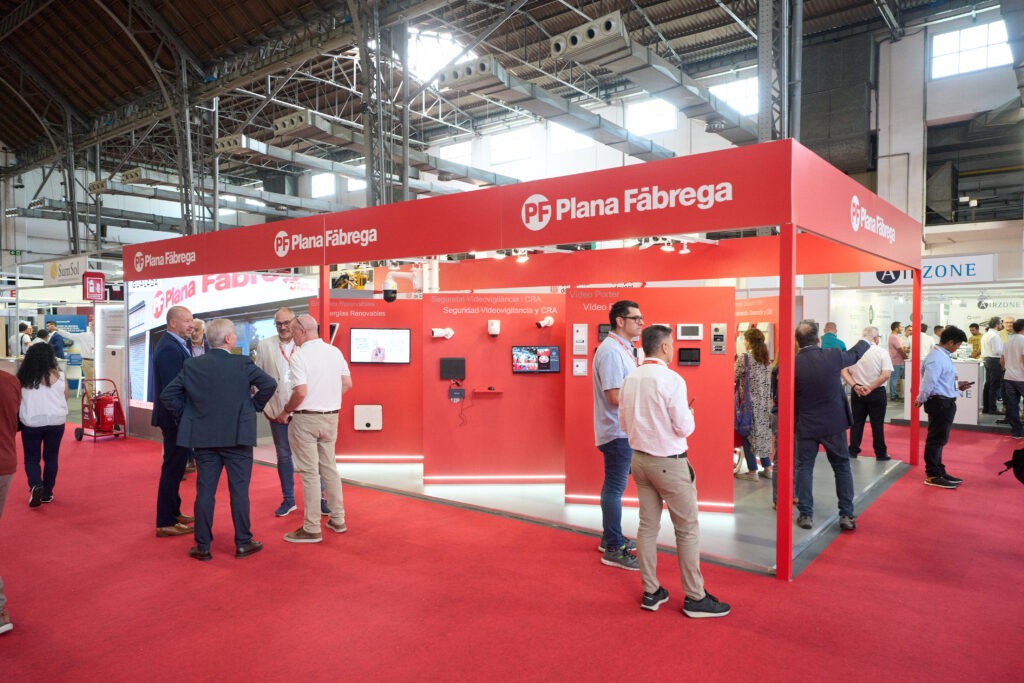
What are modular stands and when to choose them for a trade show? Knowing your modular stand options is essential for any company participating in trade shows or events. In a market full of choices, selecting the right modular system can make a difference in both design and budget. Table of contents Modular stands are a versatile, sustainable, and cost-effective solution for companies participating in trade shows or events. With a wide range of systems like Octagonal, Aluvision, Maxima, and beMatrix, they offer adaptable designs to suit any need or space, blending functionality with visual impact. This article highlights their key advantages, such as ease of assembly, customization, and sustainability, as well as the importance of selecting the right system based on each company’s goals and budget. What are modular stands? Modular stands are structures made up of prefabricated pieces that allow for quick and easy assembly. These pieces can be combined in various ways to create designs tailored to the needs of each event. Being dismantlable and reusable, they offer a sustainable and cost-effective alternative to traditional carpentry-built stands. Key features of modular stands Adaptability: Designs that fit any space. Reusable: Ideal for multiple events throughout the year. Easy assembly: Cuts down on time and logistical costs. Customization: Compatible with graphics, lighting, and other elements. Advantages of modular stands Cost savings: Their reusability allows for amortizing the initial investment, making them a more cost-effective option in the long run. Sustainability: Being reusable and producing less waste, they help reduce environmental impact. Design flexibility: From simple setups to more complex designs, they adapt to the needs of each brand. Quick assembly: Perfect for companies looking to minimize installation times. Professional aesthetics: Despite being a more affordable option, they don’t compromise on visual quality. Systems for assembling modular stands There are several modular systems known for their quality and functionality. Here’s an overview: Octagonal System The Octagonal system is a classic in modular stand design, known for its robustness and simplicity. It uses aluminum profiles connected with octagonal pieces, ensuring a stable and durable structure. Materials and assembly: Aluminum profiles are joined with standard connectors, allowing for quick and easy assembly and disassembly. Functional design: Perfect for simple setups and practical spaces. Applications: Ideal for companies seeking cost-effective and reliable solutions for recurring trade shows. Aluvision Aluvision stands out for its premium design and focus on technological integration. This modular system uses anodized aluminum profiles combined with graphics and LED displays to create a striking visual experience. Materials and assembly: High-quality aluminum profiles allow for seamless integration of technological elements like LED screens. Advanced design: Ideal for modern booths with an innovative edge. Applications: Perfect for companies aiming to stand out at tech or corporate events. Maxima Maxima is one of the most versatile systems on the market. Designed for flexibility, it allows the combination of materials like wood, fabric, or rigid panels, adapting to the specific needs of each client. Materials and assembly: Sturdy aluminum profiles offering extensive customization options. Design flexibility: Capable of creating simple or complex structures, including multi-level setups. Applications: Perfect for brands needing unique and adaptable solutions for different events beMatrix beMatrix is a modular system renowned for its ability to integrate fabric graphics and LED screens, delivering visually impactful solutions for any event or exhibition. Structure: beMatrix is lighter and more portable, whereas Aluvision focuses on premium finishes and sturdier structures. Graphics: beMatrix is optimized for fabric graphics, while Aluvision uses rigid and backlit panels. Applications: beMatrix is ideal for compact and lightweight stands, while Aluvision suits more technological and sophisticated designs. Modular Stand Systems at Servis We understand that every client and event has unique needs. That’s why we always take the time to evaluate the best options and choose the system that fits the project perfectly. It’s also worth noting that many projects combine different types of systems, such as modular structures and traditional carpentry. This approach leverages the strengths of both: the speed and flexibility of modular systems, along with the detailed customization and unique finishes that carpentry offers. For example, it’s common to use modular structures as the base of a stand, while decorative or specific elements—like counters or panels—are crafted with carpentry to achieve a more personalized result aligned with the brand’s identity. Our modulars stands examples
What is an exhibition stand
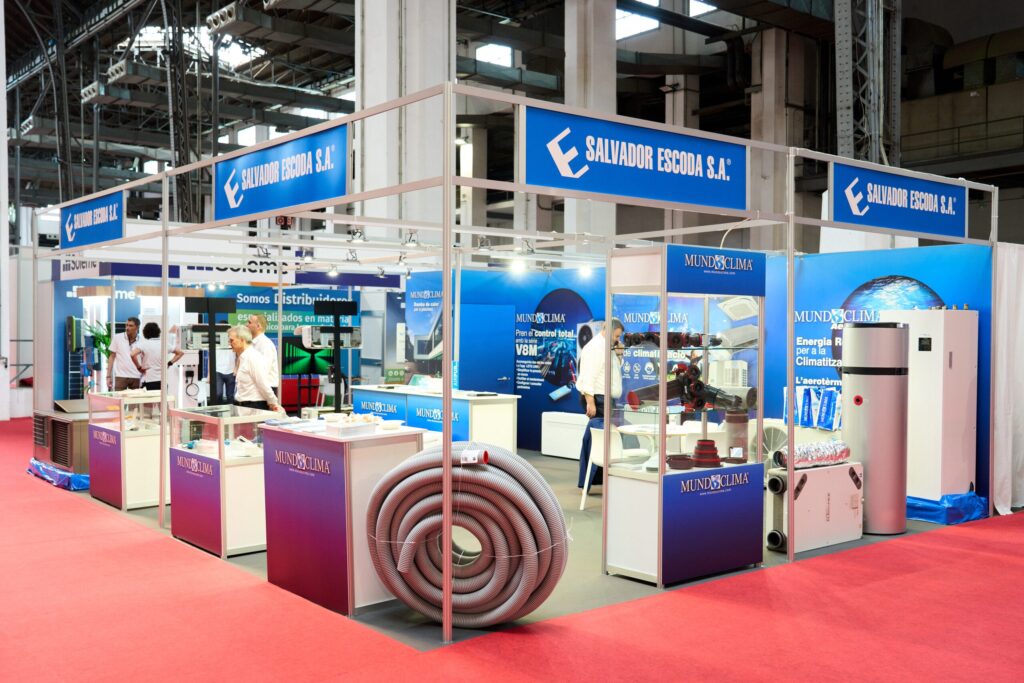
What is an exhibition stand? What is an exhibition stand: an exhibition stand is the space a company occupies at a trade fair or congress to present its offer, connect with visitors and generate business. Stands can be modular, custom built in carpentry, or mixed, and they adopt different floor types such as island, peninsula, corner or inline. Table of contents In this post, we explain what a trade show booth is and its role at an event. From boosting brand visibility to creating business opportunities and facilitating networking, a well-designed booth can make all the difference. Plus, we share key tips to make your booth effective, from its location to design and visitor engagement. What is an exhibition stand at a trade fair If you are wondering what is an exhibition stand, think of it as your brand’s temporary branch inside the venue. It is a space designed to be useful from minute one. Build visibility and brand recall Demonstrate products or services with clarity Capture leads and schedule meetings with an agile process Look after clients and partners in a comfortable setting Sell, when the format allows it At Servis we always start from your objective. We define what you want to achieve and how we will measure it. Form, materials and technology come after that. Stand types Island stand Open on all four sides. It offers the highest visibility and allows traffic from any aisle. Ideal for launches or brands with heavy footfall. It requires a 360 degree concept and usually implies a higher investment per usable square metre. Peninsula stand Open on three sides with one shared back wall. It delivers a strong balance between impact and cost. You can create a powerful main front and supporting areas on the sides. Very versatile for mid sized spaces. Corner stand Two open fronts. The key is to orient the reception on the diagonal and keep access clear to invite people in. Inline stand One open front with neighbours on both sides. Here you need a very clear front, strong graphics, careful lighting and an uncluttered entrance. It works well for compact spaces. Important:every organiser and venue defines maximum heights, setbacks and technical requirements. Before you finalise a design, review the exhibitor manual for your fair. Construction systems: modular, custom carpentry or hybrid Modular Modular stands use reusable and standardised structures that allow fast installation with tight cost control. Personalisation is lower than in a fully custom build, although there are modular solutions with a very attractive creative look.Advantages: very good value for money and a smaller environmental footprint thanks to reuse.When it makes sense: a busy calendar of fairs, the need for quick builds, or a stronger sustainability focus. We also have a dedicated article that goes deeper into modular stands. Custom carpentry Stands designed and built from scratch, generally with wood and other premium materials.Advantages: total customisation, strong visual impact, finishes that convey your brand identity.When it makes sense: strategic fairs, product launches, or when you want a stand that will not go unnoticed. Mixed or hybrid Increasingly common thanks to the flexibility of some modular systems. You combine a modular skeleton to optimise resources with carpentry elements to highlight specific features.Advantages: a good balance of personality, costs and reuse. If you want to compare all the options, we have a specific post that covers the types of exhibition stands and how to choose the right one. Key elements of a professional stand Architecture and visibility: volume, heights and long distance legibility Branding and messages: clear, short and with hierarchy so your promise is readable from five metres away Lighting: general lighting plus accents on products or demos, avoid shadows at the reception Audiovisual and interactive: screen content planned for real aisle flow Flooring and acoustics: comfort, hidden cabling, accessible platforms, treat echo in open spaces Furniture and flow: visible reception, routes without bottlenecks, comfortable meeting points Storage and back of house: essential for daily operations Accessibility and safety: ramps when there is a platform, width of passage, certified materials Commercial operations: lead scanning, meeting agenda and service script At Servis we design with operations in mind. It is not only about how it looks. It has to work. Can a stand be sustainable? Yes. A stand can be sustainable when it is designed for reuse, uses recyclable or certified materials and is managed with a clear plan. Many venues already ask exhibitors to follow these criteria. IFEMA Madrid, for example, considers stands sustainable when they use recyclable materials or materials with recycled content, such as certified wood, aluminium, melamine or new generation vinyls. Fira de Barcelona recommends prioritising reusable and recyclable materials and certifications like FSC or PEFC. Sustainability also relies on eco design. Plan for several fairs with modular systems, easily removable parts and documented recycling at end of life. Add efficient lighting with dimmable LED and consumption control. Optimise logistics with returnable packaging, consolidated transport and nearby storage. There are recognised frameworks that help you measure and reduce impact, such as ISO 20121 and the Net Zero Carbon Events initiative. In Spain, certification schemes like Eventsost provide independent validation for resources and builds that meet these criteria. If you need more detail on sustainable stands, you can read our dedicated blog post on the topic. FAQ about exhibition stands Are stand and booth the same thing In Spanish we usually say stand. In English booth is common. In international exhibitions both terms are used as equivalents. Choose the term that fits your audience. Which stand type offers the most visibility The island stand, because it is open on four sides. If your budget is tighter, a well planned peninsula stand can also deliver high impact. What regulations do I need to follow Those of the venue and the organiser. Maximum heights, setbacks, permitted materials, suspended loads and accessibility. Always check the technical manual before production. Your stand supplier may helps you with that. What is an exhibition stand and what is it
Safety measures for setting up a trade fair stand

Safety measures for setting up a trade fair stand Setting up a stand at a trade fair isn’t just about making it look good and catching attention. Safety comes first, both for the team assembling it and for those passing by. From the design to the final detail, it’s essential to comply with regulations and ensure everything is in order. Table of contents In this post, we share the keys to ensuring safety when setting up a trade fair stand. From securing stable structures and complying with regulations to managing electrical risks, preventing fires, and ensuring accessibility, we provide practical tips to create a safe and professional space that protects both the team and visitors. When setting up a stand, there are countless details that aren’t immediately visible but are key to avoiding problems. From ensuring the stability of structures to managing capacity and adhering to regulations, everything matters to ensure the result is safe and runs like clockwork. Here, we share the keys to a smooth and safe setup. Safe design and structure It all starts with a good plan. The stand must comply with: Fair safety regulations and local laws. Durable materials and solid anchors to ensure everything is stable. Spacious areas that allow people to move comfortably and, if necessary, exit quickly in case of an emergency. Electrical Risk Control Electricity always requires special attention: Installations must be carried out by qualified professionals. No DIY fixes. Use certified equipment and avoid overloads. Cables must be organized and protected to prevent anyone from tripping. Fire Prevention Prevent problems before they start Use fire-resistant materials (that don’t ignite easily). Have fire extinguishers on hand and ensure everyone knows where they are. Clearly mark emergency exits and keep access routes clear. Capacity Limitation It’s not about having a crowd, but ensuring everyone is safe: Set a maximum capacity and stick to it. Organize the space to avoid congestion in high-traffic areas. If you’re unsure how to calculate capacity, check out this blog post. Health Measures Cleanliness is also part of safety: Disinfect surfaces and products regularly. Place hand sanitizer dispensers in key areas for everyone to use. Do you have questions about your participation in a trade show? Get our free consultation! Safety in working at heights If you have to work at heights, do it right: Use stable scaffolding instead of ladders whenever possible. Make sure workers wear harnesses and helmets. Better safe than sorry. Protection of products and materials Make sure nothing gets lost or broken: Properly pack the most delicate and valuable products. Hire security or use monitored storage if you have high-value materials. Regulatory compliance This is essential to avoid last-minute surprises: Adhere to the maximum permitted heights in the stand design. Keep all required documentation for the trade fair on hand. Accessibility Everyone should be able to enter without any issues: If your stand has platforms over 5 cm, install access ramps. Ensure that walkways are comfortable and safe. Conclusion: Safety, the key to success Having a safe stand not only prevents accidents but also reflects professionalism and responsibility. With a good design, proper materials, and a well-prepared team, everything will run smoothly. If you’re looking to set up a spectacular stand without any hassle, at Servis we make sure everything is in its place. We handle the assembly and ensure no one gets a scare!
